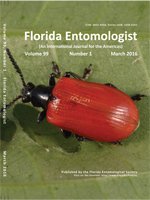The nesting biology and some foraging activities of the familiar, brilliant metallic green, small carpenter bee Ceratina (Pithitis) smaragdula (F.) (Hymenoptera: Apidae) is documented from the northwestern-most extent of its natural distribution, as the species is a potentially important pollinator of leguminous and cucurbit crops in the region. Numerous nests around the village of Ismaila, Swabi, Khyber Pakhtunkhwa Province, Pakistan, were observed and sampled from Jun through Aug 2012. Nest details were recorded and foraging times on various floral species were documented, with bees preferentially nesting in wooden stalks of Ravenna grass (Saccharum ravennae L.; Poales: Poaceae), life cycles lasting 28 to 32 d, and conditions offering the potential for easy management. The importance of such studies on wild bees in Pakistan is stressed, as are the development of biotic surveys on bees and the training of regional melittologists, coupled with outreach activities.
How to translate text using browser tools
1 March 2016
Notes on the Nesting Biology of the Small Carpenter Bee Ceratina smaragdula (Hymenoptera: Apidae) in Northwestern Pakistan
Hussain Ali,
Abdulaziz S. Alqarni,
Mohamed Shebl,
Michael S. Engel

Florida Entomologist
Vol. 99 • No. 1
March 2016
Vol. 99 • No. 1
March 2016
arquitectura de nido
biología de anidación
foraging
forrajeo
nest architecture
nesting biology
Pakhtunkhwa Province




